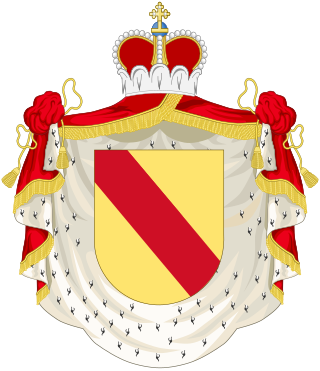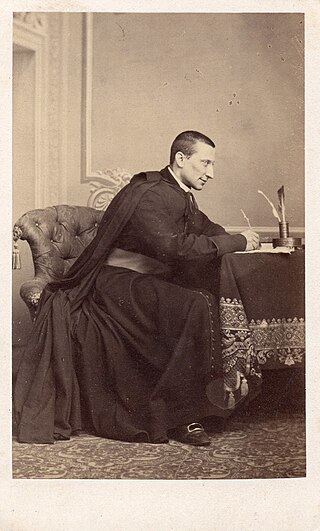
Westerlo is a municipality located in the Belgian province of Antwerp. The municipality comprises seven towns:

Kortenberg is a Belgian municipality located in the province of Flemish Brabant, about halfway between the cities of Brussels and Leuven. The municipality comprises the subdivisions or deelgemeenten of Erps-Kwerps, Everberg, Kortenberg proper and Meerbeek. On 1 January 2013 Kortenberg had a total population of 19,393. The total area is 34.52 km2 which gives a population density of about 562 inhabitants per km2. In the southern part of Everberg there is also a hamlet called Vrebos, while between Erps-Kwerps and Meerbeek there is another hamlet called Schoonaarde, which can be found in the proximity of the train station of Erps-Kwerps.

The House of Croÿ is a family of European mediatized nobility, which held a seat in the Imperial Diet from 1486, and was elevated to the rank of Princes of the Holy Roman Empire in 1594. In 1533 they became Dukes of Arschot and in 1598 Dukes of Croy in France. In 1913, the family had branches in Belgium, France, Austria and Prussia.

The House of Ligne is one of the oldest Belgian noble families, dating back to the eleventh century. The family's name comes from the village of Ligne where it originated, between Ath and Tournai in what is now the Hainaut province of Belgium.

Philippe Félix Balthasar Otto Ghislain, Count de Merode, known as Félix de Merode, was a Belgian politician. He has been called "the architect of Belgian independence'.
On the territory of the municipality of Westerlo there are several castles.
The Belgian nobility comprises Belgian individuals or families recognized as noble with or without a title of nobility in the Kingdom of Belgium. The Belgian constitution states that no specific privileges are attached to the nobility.
Prince Jean Charles Lamoral de Ligne-La Trémoïlle, 14th Duke of Thouars, 13th Duke of La Trémoïlle, 16th Prince de Tarente, 20th Prince de Talmond and 20th Count of Laval, was a Franco-Belgian nobleman and the only child of the French Princess Charlotte de La Trémoïlle, 13th Duchess of Thouars, and her Belgian husband, Prince Henri-Florent de Ligne. Upon the death of his mother in 1971, he succeeded to all of her French noble titles, as well as disputed potential claims to the Kingdom of Jerusalem.

Xavier de Mérode was a Belgian prelate, archbishop and statesman of the Papal states.

Jean-Philippe-Eugène, Count de Mérode, 5th Marquess of Westerloo was a Belgian soldier and Feldmarschall of the Holy Roman Empire and a prominent member of the House of Merode. In Flemish and Dutch sources, he is known as Jan Filip van Merode-Westerloo.
Everberg is a town in the Belgian province Flemish Brabant and is part of the municipality of Kortenberg. The territory covers an area of 925 ha. The neighbouring towns or municipalities are Leefdaal, Kortenberg, Erps-Kwerps, Meerbeek, Sterrebeek, Moorsel and Tervuren. A small hamlet, called Vrebos, can also be found in Everberg.

Solre-sur-Sambre Castle is a water castle in Solre-sur-Sambre in the municipality of Erquelinnes, province of Hainaut, Wallonia, Belgium. It is one of the oldest fortified castles in Hainaut, and the property of the Princes de Merode.

Carlo Emanuele dal Pozzo, 5th Prince of La Cisterna was a nobleman and politician in the Kingdom of Sardinia. His other titles were 5th Principe di Belriguardo, 6th Marchese di Voghera, 6th Conte di Reano, 8th Conte di Ponderano, 8th Conte di Bonvicino, 6th Conte di Neive, 6th Conte di Perno, among others.

Countess Louise de Mérode was a member of the House of Merode by birth and Princess della Cisterna by marriage.

Jean Charles Joseph, Count of Merode, Marquess of Deynze was a noble of the Austrian Netherlands, born in the Prince-Bishopric of Liège. He was Lieutenant-Feldmarschall of the Holy Roman Empire, Knight of the Order of the Golden Fleece.

Vilain and Vilain XIIII is a Belgian noble family. Their coat of arms is basically "Sable, on a chief argent a label of the field", a colour scheme that is present from the earliest Vilains in the 15th century, and is also seen in the Vilain XIIII arms, which have the "XIIII" added to it.

The House of d'Udekem is the name of a noble family that has belonged to the nobility of Belgium since 1816.
The Lords of Westerlo were the feudal lords of the fiefdom of Westerlo until the abolition of feudalism in 1795. The first known Lord of Westerlo was the Frankish nobleman Ansfried of Utrecht who gave this domain as allodial title to the chapters of Saint-Martin and Saint-Salvator in Utrecht after he became Bishop of Utrecht in 995. Since the late 15th century the Lords of Westerlo have been members of the House of Merode. In 1626 Westerlo was elevated to the rank of marquessate by King Philip IV of Spain in favor of Philippe I de Merode who became the first Marquess of Westerlo. The chief of the House of Merode stil bears the title of Marquess of Westerlo although the feudal rights attached to this title have been abolished since 1795. In the nineteenth and first half of the twentieth century the 10th, 11th and 12th Marquess have been elected Burgomaster of Westerlo.

Prinsenkasteel was a castle located in Grimbergen, Belgium. It was the residence of the lords of Grimbergen from the 14th Century onwards. The castle ruins are located in Prinsenbos Park.
Count Henri Marie Ghislain de Merode (1782–1847) was a member of the Belgian Senate and writer.


























